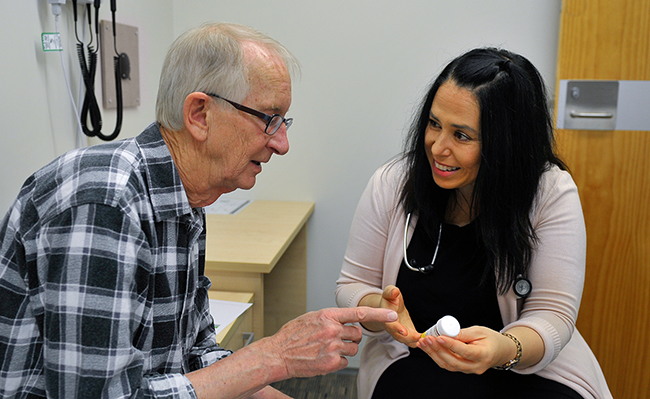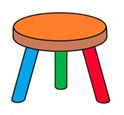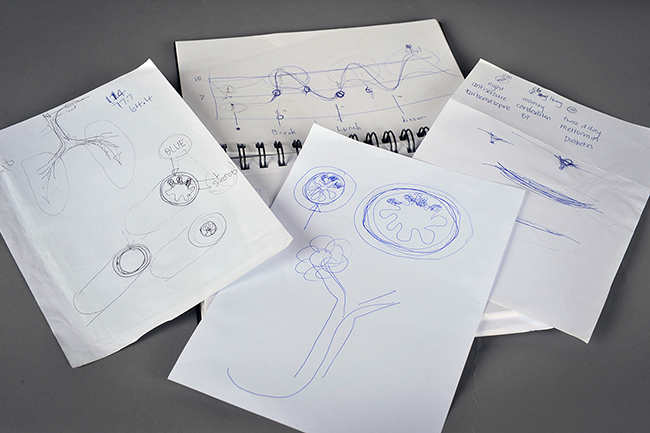Latest resources
Our resources for health professionals were revised at the end of our medication review research project in accordance with our findings and including examples of real talk taken from the recorded interactions. Links to these are below.
Previous resources
Below is information provided for health professionals in general practice participating in the research project "Reviewing Medications for Older Adults". It replicated the text of the written resource for health professionals used in the research, with the addition of references, plus provides additional background and links. Examples of talk are taken from real-life recordings of New Zealand health consultations.

Background
This background section gives the rationale for the creation of this resource, with particular reference to Māori and Pacific populations for whom health inequities persist. References to the literature are included and full details of each reference are at the bottom of this page.Increasing age can change the relative benefits and risks of medication. Clearly concurrent use of multiple medicines is necessary at times, but polypharmacy among older adults can be harmful due to side effects, drug interactions, and drug-related hospitalisations (Canadian Deprescribing Network, 2016; Mangin, Sweeney, & Heath, 2007; The Best Practice Advocacy Centre New Zealand (bpacnz), 2012).
While desprescribing may be indicated, optimising medications may mean many things, including making sure that patients are prescribed all the medications they need, especially for some groups.
Māori and Pacific populations
It is important to remember that multimorbidity and polypharmacy is more common among Māori and Pacific ethnic groups (Stanley, Semper, Millar, & Sarfati, 2018). These groups also receive more medicines at a younger age compared with those identifying as Asian or European/Other (Health Quality and Safety Commission New Zealand, 2019). Unfortunately, Māori tend to receive medicines at a lower rate than their higher health needs would indicate (Pharmac/Te Pātaka Whaioranga).
Communication with patients when reviewing medications
There is a lot of clinical advice on how manage changes to medication. This resource focuses on thinking about the communication needs when reviewing medications with patients.
Like all good consultations, medication review conversations (whether in routine appointments or specific review appointments) rest on the following components (using the image of a 3-legged stool):
 Integrating best research evidence with clinical expertise and patient values (Sackett et al. BMJ 1996)
Integrating best research evidence with clinical expertise and patient values (Sackett et al. BMJ 1996)
- Best available research evidence (first leg of the stool)
- Clinical judgement of the practitioner (second leg)
- Patient's circumstances, goals, values and wishes (third leg)
(Le Bosquet, Barnett, & Minshull, 2019)
This communication resource
Our focus in this resource is on the final leg of the stool which relies on the importance of trust and relationships.
This is fundamental for all patients but may be of even more importance to patients of Māori and Pacific background (Bassett-Clarke, Krass, & Bajorek, 2012; Jansen et al., 2016; Ludeke et al., 2012; Signal et al., 2017; Te Karu, Bryant, Harwood, & Arroll, 2018) and Asian backgrounds (Ng, Tan, Koh, & Tan, 2017).
That said, it's worth remembering that these are generalisations and we all need to work to avoid making assumptions about cultural traits or patient preferences (Scotney, Guthrie, Lokuge, & Kelly, 2010), as these are all too easy to make (Bassett-Clarke et al., 2012).
Research shows that patients sometimes need and desire more information about their medicines and the review process than we realise (Bassett-Clarke et al., 2012; Hikaka et al., 2020; Signal et al., 2017; L. Swain & Barclay, 2013; L. S. Swain & Barclay, 2015).
Shared decision making is important even as patients age; research shows that it tends to occur less with older adults (Meijers, Noordman, Spreeuwenberg, olde Hartman, & van Dulmen, 2019).
Changing medications may be a delicate subject to broach with older people as they may feel threatened or feel that stopping medications means being given up on (Schuling, Gebben, Veehof, & Haaijer-Ruskamp, 2012).
They may also be concerned that symptoms may be dismissed as 'merely' age-related (Hikaka et al., 2020). However, many older adults are often open to reducing their medications, contrary to popular belief (Reeve et al., 2018).
The hui process
(Lacey, Huria, Beckert, Gilles, & Pitama, 2011)
We have incorporated the hui process into our Communication tips for medication reviews. This is a framework that has been developed within the University of Otago to guide clinical interaction with Māori but we believe that the basic principles apply to any good consultation.
This way of structuring a consultation is based on four key elements:
- Mihi (initial greeting and engagement)
- Whakawhānaungatanga (making a connection)
- Kaupapa (attending to the main purpose of the encounter)
- Poroporoaki (concluding the encounter)
When Māori patients are involved, there may be some specifics to be aware of. Clinicians should confirm with the patient whether they identify as Māori during the initial mihi (introduction).
The Whakawhānaungatanga element includes 'building rapport' but may go beyond this with Māori patients. It requires clinicians to draw on their understanding of Te Ao Māori in terms of acknowledging the patient's whenua (land) connections and the use of te reo (Māori language) and includes some self-disclosure by the health professional about their own experience of Te Ao Māori.
Making connections may be particularly important with some Māori and Pacific patients who may come to health interactions with negative expectations, based on previous experiences within the health system which have led to a lack of trust.
The emphasis of the Kaupapa (clinically focussed) part of the consultation in this model is on encouraging a broader focus on the patient and their situation more holistically, including societal factors.
The Poroporoaki (closing) is a part of the consultation which has been found to be sub-optimal and incomplete for Māori patients (Cram, Smith, & Johnstone, 2003). The emphasis here is on paying extra attention to making sure both sides have understood each other and that the patient is clear about next steps.
Avoiding jargon / using clear, plain language
It can be challenging to communicate some concepts in simple terms. You may need to use more words to explain something like 'optimising your medications'. For example, talking about how the aim is to make sure their medicines are giving them the best results at the current time and that this might mean adding more medicines or stopping some or changing how much is taken (increasing or reducing).
Communicating the risks and benefits of medicines and changes to them is another area that can be tricky – you may need to be creative in finding ways that are meaningful to the person in front of you. Remember to make use of metaphors and images that relate to familiar aspects of their lives, without stereotyping.
Communication tips
Printable version (PDF)
Principles:
- Aim for shared decision-making. Be aware that there is a tendency to use shared decision making less with older adults. Ensure that patients can make informed decisions and take appropriate actions to protect and promote their health.
- Do your part for health literacy. Remember that this concept encompasses your capacity as a health professional to communicate effectively so that the above goals can be met. (Health Navigator New Zealand) Work with an appropriate interpreter if needed.
1. Mihimihi | Greeting and engagement
After you've introduced yourself to the patient and their whānau / support person and confirm their details, check what the purpose is of the consultation is from the patient's point of view.
2. Whakawhānaungatanga | Making connection
Remember to take some time to connect with the patient and whānau / support person on a personal level.
3. Kaupapa | Purpose of appointment
- Aim for clear plain language (Hikaka, Jones, Hughes, & Martini, 2020; Ludeke et al., 2012) without being patronising or oversimplifying (Abbott, Dave, Gordon, & Reath, 2014) – avoid jargon.
- Reassure the patient (if necessary) that the review is nothing to worry about.
-
Elicit patient perspectives and preferences. (Jansen et al., 2016; Reeve, Thompson, & Farrell, 2017; Wai et al., 2010) This helps you to avoid making assumptions.
- What are the patients' preferences (including how much information they want)?
- What are the patients' goals?
- What is important to the patient (this may be different from what you consider important)?
- What fears and worries do they have?
- Use simple open wording like: “Tell me about…” or “How do you feel about making changes to your medications?” (Weir, Jansen, Bonner, McCaffery, & Naganathan, 2018)
- Proposing medication changes (for some this may mean more, for others less medication). Here some examples from real consultations: Could you tolerate increasing the dose to one now?; Would you be able to stop [your tablet] or would you just not manage with your knees?
- Be aware that some patients may view stopping medication as a sign they have been given up on because of their age.
- Provide information about options and risks (including side-effects) and benefits. Be mindful of the information load for patients. Some will want more, although some may not and others may want information to take away.
- Remember the power of visuals when explaining. (Rolston et al., 2018)

-
Check understanding if you need to use technical terms or medication names. Offer explanation.
E.g. Did anyone explain what the word [technical term] means?
Losec, you know - the table that protects your stomach from the Voltaren. - Non-verbals may be misleading – some patients may nod or otherwise indicate agreement without really understanding or asking questions. (Ludeke et al., 2012)
-
Explicitly invite patient questions. Some patients may worry that asking questions is a challenge and a threat to the relationship.
Example questions your patient might want to ask:- Do I still need to take all these medicines?
- Why am I taking this medicine?
- What are the benefits and risks?
- How long do I need to take this medicine?
- What happens if I forget a dose?
- Is this a side effect of this medicine?
- Why have my medicines been changed?
- What happens if I stop this medicine?
- Do I need any tests?
- How do I know this medicine is working?
- Exploring patient resistance to recommendations
Use patient resistance as an opportunity to explore and acknowledge patient perspectives, as in this real-life example (from the ARCH Corpus: TS-GP15-01):
| PT: because I don't really want to do that | |
| Acknowledge PT stance | GP: you don't really want to do that |
| PT: no because I'd rather try and bring it down, I don't know, but I don't want to really go on that, on tablets | |
| Elicit PT perspective | GP: mm, okay. What is your concern around the tablets? What don't you like about the idea?.... |
| PT: I don't want to take any other tablets that I have to take for life… | |
| Acknowledge PT perspective and explain reason | GP: I know it's annoying to think that you will have to take this tablet for life, but normally with high blood pressure it's something that develops and it doesn't go away again because of the aging of the arteries |
4. Poroporoaki | Next steps and closing
- Conclude the consultation with clear next steps for the patient and whānau/support
- Reflect on:
- Did you understand what the patient said? How do you know?
- Did the patient understand what you have said? How do you know?
- Some people find the “Teach Back” technique useful (Health Navigator New Zealand, 2016) but be careful not to make it sound like a quiz.
E.g. What will you tell your [partner/mother/etc.] about the changes we made to your medicines today?
- Clearly identify the next steps for the patient and whānau/support person.
Follow-up appointment □ Referral to tests □
- Give the patient a written record of their medications and how to take them.
E.g. So if I just give you this – it shows you what you're on and what I've got you on it for.
Resources and links
Printable clinician resources
Download our printable Clinician's Communication tips pamphlet:
Printable patient resources
Download our printable Patient pamphlet:
Download printable forms to give patients a list of their medications:
Printable individual medicine information sheets for patients (website links)
In English
- My Medicines: 514 information sheets on individual medications in plain language for patients
- Health Navigator medicine information sheets
In other languages
- Te Reo Māori information sheets on 70 individual medications
- Other languages including Samoan and Tongan (a range of health topics)
Other Links
Questions for patients to ask (on the Health Navigator website which is highly rated by health professionals)
Clinical toolsfor appropriate prescribing and deprescribing (on the Health Quality & Safety Commission website)
References
Abbott, P., Dave, D., Gordon, E., & Reath, J. (2014). What do GPs need to work more effectively with Aboriginal patients? Views of Aboriginal cultural mentors and health workers. Australian family physician, 43(1), 58-63. Retrieved from https://www.scopus.com/inward/record.uri?eid=2-s2.0-84893204204&partnerID=40&md5=b1c68d48c9129c316ea6016ba08c064f
Bassett-Clarke, D., Krass, I., & Bajorek, B. (2012). Ethnic differences of medicines-taking in older adults: A cross cultural study in New Zealand. International Journal of Pharmacy Practice, 20(2), 90-98. doi:http://dx.doi.org/10.1111/j.2042-7174.2011.00169.x
Canadian Deprescribing Network. (2016). Annual Report 2016. Retrieved from Montreal, Canada: https://deprescribing.org/wp-content/uploads/2015/11/CaDeN_Annual-Report_23Jan2017_EN_WEB.pdf
Cram, F., Smith, L., & Johnstone, W. (2003). Mapping the themes of Maori talk about health. New Zealand Medical Journal, 116(1170).
Health Navigator New Zealand. Health Literacy. Retrieved from https://www.healthnavigator.org.nz/clinicians/h/health-literacy/
Health Navigator New Zealand. (2016, 22 JUL 2018). Teach back - Explained. Retrieved from https://www.healthnavigator.org.nz/videos/h/health-services-quality-improvement/teach-back-explained/
Health Quality and Safety Commission New Zealand. (2019, 15 February 2019). Polypharmacy in people aged 65 and over. Retrieved from https://www.hqsc.govt.nz/our-programmes/health-quality-evaluation/projects/atlas-of-healthcare-variation/polypharmacy
Hikaka, J., Jones, R., Hughes, C., & Martini, N. (2020). “It is through shared conversation, that I understand”—Māori older adults' experiences of medicines and related services in Aotearoa New Zealand. New Zealand Medical Journal, 133(1516), 33-46.
Jansen, J., Naganathan, V., Carter, S. M., McLachlan, A., Nickel, B., Irwig, L., . . . Turner, R. (2016). Too much medicine in older people? Deprescribing through shared decision making. British Medical Journal, 353(i2893).
Lacey, C., Huria, T., Beckert, L., Gilles, M., & Pitama, S. (2011). The Hui Process: a framework to enhance the doctor-patient relationship with Māori. New Zealand Medical Journal, 124(1347), 72-78.
Le Bosquet, K., Barnett, N., & Minshull, J. (2019). Deprescribing: Practical Ways to Support Person-Centred, Evidence-Based Deprescribing. Pharmacy, 7(3), 129. Retrieved from https://www.mdpi.com/2226-4787/7/3/129
Ludeke, M., Puni, R., Cook, L., Pasene, M., Abel, G., & Sopoaga, F. (2012). Access to general practice for Pacific peoples: A place for cultural competency. Journal of Primary Health Care, 4(2), 123-130. Retrieved from https://www2.scopus.com/inward/record.uri?eid=2-s2.0-84862501920&partnerID=40&md5=16268aacb31e3aa759f7ef1592ca2e87
Mangin, D., Sweeney, K., & Heath, I. (2007). Preventive health care in elderly people needs rethinking. BMJ, 335(7614), 285-287. Retrieved from https://www.ncbi.nlm.nih.gov/pmc/articles/PMC1941858/pdf/bmj-335-7614-ac-00285.pdf
Meijers, M. C., Noordman, J., Spreeuwenberg, P., olde Hartman, T. C., & van Dulmen, S. (2019). Shared decision-making in general practice: an observational study comparing 2007 with 2015. Family Practice, 36(3), 357-364. doi:10.1093/fampra/cmy070
Ng, W. L., Tan, M. Z. W., Koh, E. Y. L., & Tan, N. C. (2017). Deprescribing: what are the views and factors influencing this concept among patients with chronic diseases in a developed Asian community? Proceedings of Singapore Healthcare, 26(3), 172-179.
Pharmac/Te Pātaka Whaioranga. (9 July 2020). Māori uptake of medicines. Retrieved from https://www.pharmac.govt.nz/tools-resources/research/maori-uptake-of-medicines/
Reeve, E., Thompson, W., & Farrell, B. (2017). Deprescribing: a narrative review of the evidence and practical recommendations for recognizing opportunities and taking action. European Journal of Internal Medicine, 38, 3-11.
Reeve, E., Wolff, J. L., Skehan, M., Bayliss, E. A., Hilmer, S. N., & Boyd, C. M. (2018). Assessment of Attitudes Toward Deprescribing in Older Medicare Beneficiaries in the United States. JAMA Internal Medicine, 178(12), 1673-1680. doi:10.1001/jamainternmed.2018.4720
Rolston, C. J., Conner, T. S., Stamp, L. K., Neha, T., Pitama, S., Fanning, N., . . . Treharne, G. J. (2018). Improving gout education from patients' perspectives: a focus group study of Māori and Pākehā people with gout. Journal of primary health care, 10(3), 194-200. doi:10.1071/hc18010
Schuling, J., Gebben, H., Veehof, L. J. G., & Haaijer-Ruskamp, F. M. (2012). Deprescribing medication in very elderly patients with multimorbidity: the view of Dutch GPs. A qualitative study. BMC family practice, 13(1), 56. doi:10.1186/1471-2296-13-56
Scotney, A., Guthrie, J. A., Lokuge, K., & Kelly, P. M. (2010). "Just ask!" Identifying as Indigenous in mainstream general practice settings: a consumer perspective. Medical Journal of Australia, 192(10), 609-609. doi:10.5694/j.1326-5377.2010.tb03651.x
Signal, L., Semper, K., Stairmand, J., Davies, C., Millar, E., Dowell, T., . . . Sarfati, D. (2017). A walking stick in one hand and a chainsaw in the other: patients' perspectives of living with multimorbidity. New Zealand Medical Journal, 130(1455).
Stanley, J., Semper, K., Millar, E., & Sarfati, D. (2018). Epidemiology of multimorbidity in New Zealand: a cross-sectional study using national-level hospital and pharmaceutical data. BMJ Open, 8(5), e021689. Retrieved from https://www.ncbi.nlm.nih.gov/pmc/articles/PMC5988147/pdf/bmjopen-2018-021689.pdf
Swain, L., & Barclay, L. (2013). They've given me that many tablets, I'm bushed. I don't know where I'm going: Aboriginal and Torres Strait Islander peoples' experiences with medicines. The Australian journal of rural health, 21(4), 216-219. doi:https://dx.doi.org/10.1111/ajr.12053
Swain, L. S., & Barclay, L. (2015). Exploration of Aboriginal and Torres Strait Islander perspectives of Home Medicines Review. Rural and remote health, 15, 3009. Retrieved from http://ovidsp.ovid.com/ovidweb.cgi?T=JS&PAGE=reference&D=med12&NEWS=N&AN=25711405
Te Karu, L., Bryant, L., Harwood, M., & Arroll, B. (2018). Achieving health equity in Aotearoa New Zealand: the contribution of medicines optimisation. Journal of primary health care, 10(1), 11-15. doi:10.1071/hc17067
The Best Practice Advocacy Centre New Zealand (bpacnz). (2012). Managing medicines in older people (BPJ 47). Retrieved from https://bpac.org.nz/BPJ/2012/october/elderlyMedicines.aspx
Wai, K. C., Elley, C. R., Nosa, V., Kennelly, J., Mabotuwana, T., & Warren, J. (2010). Perspectives on adherence to blood pressure-lowering medications among Samoan patients: qualitative interviews. Journal of primary health care, 2(3), 217-224. Retrieved from http://ovidsp.ovid.com/ovidweb.cgi?T=JS&PAGE=reference&D=med8&NEWS=N&AN=21069117
Weir, K., Jansen, J., Bonner, C., McCaffery, K., & Naganathan, V. (Producer). (2018, 28 July 2020). Medicines Conversation Guide. Retrieved from https://ses.library.usyd.edu.au/handle/2123/18330
